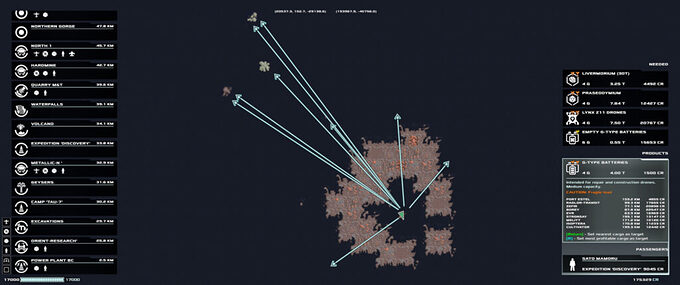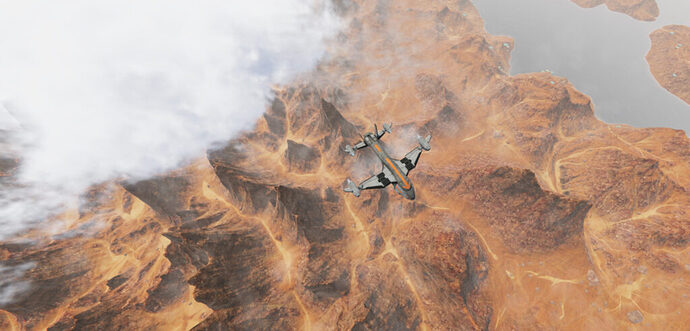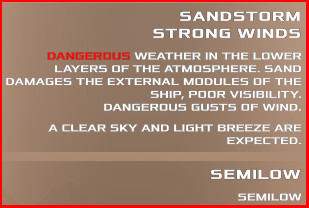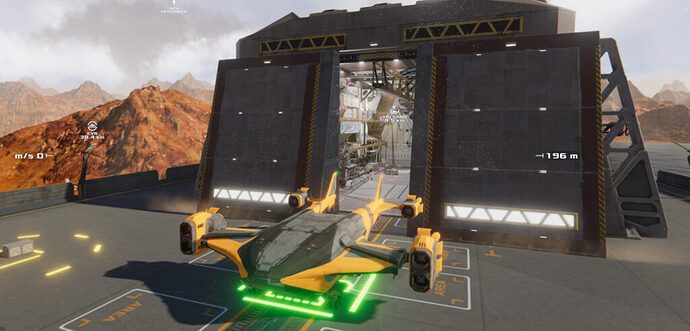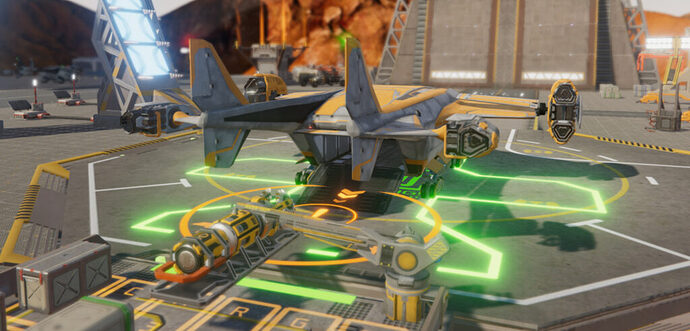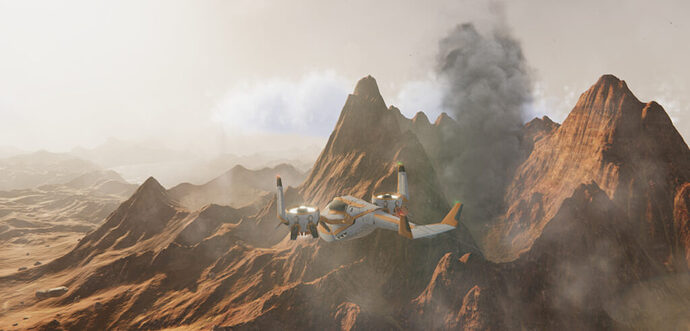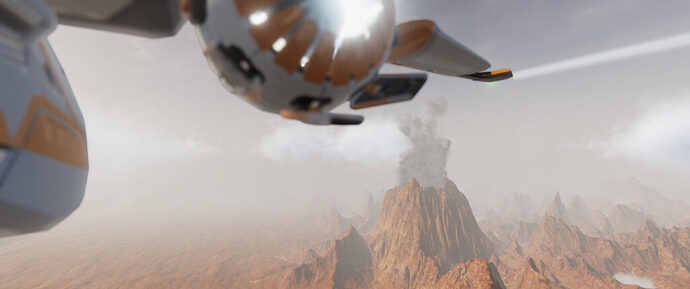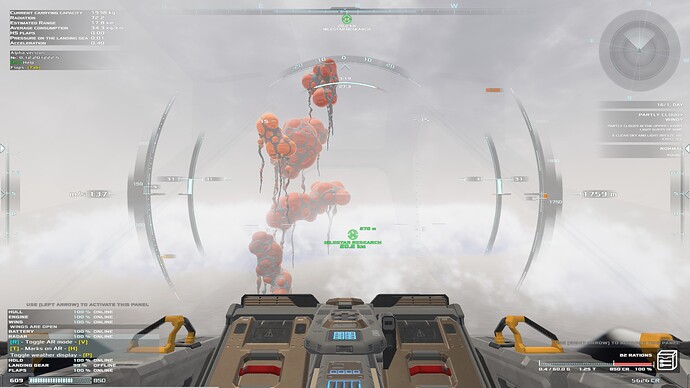Frontier Pilot Simulator
By @BeachAV8R - January 15, 2021
Originally published at: Articles - Mudspike Forums
With a focus on flying skill and efficiency, Frontier Pilot Simulator is a standout experience for fans of stick-and-rudder type simulations…
While browsing through the annual Fall season Steam Sale, I came cross the thumbnail graphic for Frontier Pilot Simulator, clicked on it, and started reading the description. The intro paragraph was a pretty easy sell for me, despite not having ever heard of the game before:
“Frontier pilot simulator is an environment centered single player vehicle sim. Combining the skill-based flying system with: a story-driven economic progression system, dozens of ships-upgrades and great flight physics. Your piloting expertise will be constantly challenged by the world while it unfolds before you.”
I took a look at some of the user reviews and the Steam forum comments on the game, and thought it sounded reasonably good. Though still in Early Access since January of 2018, I was lucky in my lack of awareness of this title since the game has continuously improved over the Early Access period. As a result, the version I purchased and played was quite refined and allowed for completion of the game with very few bugs.
What did I find? Well, Frontier Pilot Simulator earned the title of my best game/sim experience of 2020! Yes, Microsoft Flight Simulator is up there too, but the small development team at Prague based RAZAR s.r.o. have published a really cool game that appeals to my particular desires in a game. How much fun was it? I sunk an unheard of 62 hours into the game over the span of just two weeks! Apparently I took the job of being a Frontier Pilot very seriously.

Game premise
As a Frontier Pilot, you will participate in an open world roaming simulation of being a planet based pilot ferrying passengers, cargo, commodities, and other materials across a vast map sprinkled with interesting locations, ports, bases, and mysterious sites. There is an underlying story/quest that drives you along, but it is so well integrated that it genuinely feels like you are uncovering more of the story as the hours pass. The pacing and discovery that is part of the story is near perfect in my opinion, hitting just when you are wondering what is next. There is an end to the story (with a promise of more to come!), but with over sixty hours invested in gameplay, I felt my money vs. time spent was an exceptional value.
In some ways, FPS feels like the spiritual successor to the fantastic 1998 classic PC game “Hardwar” minus the combat potential. FPS is strictly a flying and economy game with no weapons – which might seem like a limiting factor, but the flight modeling is so much fun that weapons are unnecessary. The game is further enhanced by a wealth of ship upgrade options for the three classes of craft, excellent graphics, and a unique environmental system that provides much of the challenge to the game.
Environment
At the beginning of the game, you will be tasked with some basic transportation tasks that will introduce you to the game. Your first missions take place on a group of islands that have bases with relatively short flight distances between them. This is important because a major game mechanic is fuel burn and range of the ships you will fly. During the short period I was playing the game, the developer added a few smaller outlying islands to further expand the initial gameplay environment. Further into the game, you will find ship upgrades that will make possible the jump to a much larger and expansive island where the bulk of the missions and story unfold. Scattered across the map are dozens of landing pads, bases, points of interest, and other features, each with a unique layout and construction. The terrain varies between stretches of water, volcanoes, deep ravines, and spewing geysers – all of which present hazards to navigation and your ship’s survival.
Working against you in concert with the terrain are the two other main gameplay features – weather and radiation. The randomized weather changes over time as you play the game with weather forecasts and warnings being issued by the Meteorological Center. Weather conditions range from clear skies with unlimited visibility to low cloud decks, limited visibility, cyclones, and dust storms. Weather directly impacts the capability to safely complete job assignments and you will have to develop strategies to deal with the hazards presented.
Some examples of Meteorological Center conditions forecasts…Along with weather considerations is the SKI flight level forecast. SKI is a measure of environmental radiation which limits how high you can fly before the radiation starts affecting ship systems. SKI level, just like weather, has flight planning and mission execution ramifications that factor into decision making and whether you can accept a flight or not. SKI level and weather are independent from one another, which means that there are times that radiation becomes the limiting factor and other times weather becomes the main concern. Both weather and SKI have a dramatic affect on the efficient operation of the ship since winds aloft and altitude impact the range of your ship.
Ships
The initial ship class is the small Scarab, capable of carrying limited loads and of a limited range. With wingtip mounted engine nacelles, the Scarab is one of the most maneuverable ships in the game, but lacks the power and load capacity that will be required for later missions. The “drug” that keeps players coming back is both the unfolding storyline along with the ever present desire to upgrade your ship. You are free to roam the entire world finding missions and commodities to trade between bases, earning credits that can be used for ship upgrades. Base hangars that offer ship upgrades are scattered across the map, but not every base has parts for all classes of ships, and sometimes specialized parts are only in certain locations. Each ship upgrade has advantages and disadvantages and you weigh variables such as cost, power, weight, and cargo volume. Some upgrades improve engine performance, while others improve things like cargo dampening capability or reduce damage from hard landings. External battery banks, more efficient wings, and other options can drastically improve the capability of each ship. Exploring the base hangars and hunting through the offered upgrades while looking at your credit balance is a compelling addiction. Pilots can also find paint schemes and adjust colors for a small payment of credits.
Sifting through the various ship upgrades gives incentive to pursue more credits… The hangar scenes are very cool and moody as your upgrades are installed by robotic arms. Current weather conditions swirl around outside the hangar doors…As you progress through missions and gain credits through assignments (or just open world flying) you will eventually need to upgrade to larger ships with more cargo carrying capacity. Ships can be purchased at certain select bases and all ships can be upgraded with various parts. It is not necessary to sell your old ships, and in fact you may want to hang on to your smaller ships since later missions may be more easier to accomplish with smaller and more maneuverable vehicles. Your previous ship will be stored wherever you bought the new ship. Beyond the starter Scarab you will see the medium-lift Ox and the heavy-lift Ballena – both of which will cost significant amounts of credits, but each offers a logical upgrade path where the bigger your ship = the more profitable your cargo runs. Each ship has distinct performance and handling differences.
Each vehicle has the capability of carrying passengers and/or cargo. Enterprising Frontier Pilots will quickly learn to combine loads and passengers to maximize profit when planning flights. During the execution of missions, you can also load other cargo if you have the space to double up. Be careful though – some missions require expedience, so stopping to make a buck might cost you in the long run. Cargo can be loaded or unloaded at any point on the map, but most of your transactions will occur on the passenger or cargo landing pads at the various bases across the map. Cargo capacity is limited in both volume and weight depending on the ship and configuration. There is a nice loading crane sequence each time you load or unload cargo and passengers will request the loading ramp to be opened or closed as they get on or off the ship.
Ship upgrades are undoubtedly one of the most integral and fun part of the game. More efficient engines, better wings and landing gear, sensor upgrades all play in important role as the game gets more difficult with worse weather, heavier loads, and trickier flying tasks.
Eventually you will want to fit extendable wings to the Scarab to allow you to escape the smaller islands to the main quest island… Upgraded engines allow for a heavier lift capability and more power margins when carrying heavy loads…Flight controls
As mentioned, this game is largely a flying game – the cockpits are not interactive and everything you need to do can be done via your controller and mouse. I would guess that if you enjoy helicopter sims and precision flying in a tricky beast such as the DCS Mi-8 – this sim will scratch that itch in spades. My first warning is that in the first few hours – you are going to crash – probably a lot. The good news is, there is insurance on your ship so ship destruction deducts credits, but you get your ship back (but not the cargo). An interesting and fun to watch game feature is that upon crashing your ship AI senses it and automatically ejects you in an escape pod – which then flies across the map to the nearest ship-equipping base where you will get a new ship. I do think the credit deduction is a bit too easy – the penalty for crashing should be much harsher.
Controls can be mapped in whatever configuration you want. I used my HOTAS Warthog and Slaw Device pedals and they worked perfectly. You can even use an X-Box controller and there may even be some advantages to that given the neutral position of the X-Box sticks. I would highly recommend spending the first few hours on a throwaway campaign save slot and just spend time refining the control assignments and learning how to fly the aircraft – because it takes some getting used to. All of the ships are VTOL (Vertical Take Off and Landing) capable, and all can also transition to full forward flight by unfolding wings and tilting engine nacelles (the Scarab will require a wing upgrade to accomplish this). Flight characteristics when in VTOL mode versus airplane mode are vastly different and the transition between the two will take time to master – particularly when loaded to near maximum VTOL takeoff weight. You will crash. You will. Really. But you will learn how to fly the vehicles and after a few hours you will be flying just fine, but you’ll still occasionally crash because of bad decision making and impatience. Yes. You will.
The flying characteristics of the vehicles really do make this game a gem. The developers put a lot of time and thought into the physics of the game and it truly feels like you are piloting something with mass and inertia. The game rewards both efficiency in operating the aircraft and thoughtful use of the controls – perhaps tilting toward conservative flying resulting in less disastrous results. There were quite a few times I got hurried and ended up mushing my vehicle into the ground or sea because I was being stupid. The physics feel great. On-screen monitors provide an indication of your weight, carrying capacity, and things such as systems damage, fuel load, and what cargo and passengers are onboard. Passengers will occasionally talk to you via dialog boxes and in some cases you can actually pick responses to their questions or statements. In this way, you learn a bit about the strange environment you are flying though. (I’m not saying it’s aliens..but it might be aliens…). You can recall messages and in some cases you can also initiate communication to certain characters that have a major role in the storyline.
There may be times you get mid-transport reassignments or requests that you can defer or hop on depending on your current location or whether you are in the process of running other cargo or passengers. As I mentioned, I feel the missions and quests are nearly perfectly timed with revenue and ship gains. Is there a grind to it? Yes, a bit since you are having to earn credits, but I did not find it unpleasant because I was always interested in exploring and revealing more of the environment as well as the storyline.
A medium-lift capable Ox sits next to a light-lift Scarab as a size comparison… Dozens of side quests and unique missions will occur over the timeline of the story…Over time, you will learn the map pretty well and will also get a flavor for the mission types and a bit of insight about the plot characters as you range out to different stations. You will also learn of some profitable “milk runs” where commodities can earn you some nice credit profits that you can then put toward ship upgrades. The nice feature of the game is that almost all of the stage lengths are only four or five minutes long due to the fuel burn rate and the size of the map. With around 200km being the maximum length you don’t spend a lot of time in cruise flight. A map is available when on the ground that shows station inventories, routes, and allows you to locate the most profitable bases for your cargo or the shortest stage length if you need to do a quick run for less money.
Circling back around to the ship controls – there is a nice capability to map a shifted state to your controls as well as a toggle for the VTOL to airplane mode transition. Once in VTOL mode you can set your controls so that you can have relatively fast VTOL mode control with vectored thrust from tilting the engine nacelles, or you can go into what I can only describe as a pseudo-VCAP mode where throttle still controls power output of the engines, but the stick transitions to a translate forward/backward and left/right mode. So a normal approach to landing would encompass: transition from cruise to slow flight > slow flight to flaps down > flaps down to VTOL mode while bringing in more and more power > slow in VTOL mode until the very final approach > enter shifted control state (I accomplish this by pressing and holding my pinkie button on the stick) to refine the landing at the intended spot. The control scheme is superb and is highly entertaining and challenging. For heavy lifts or stage lengths were fuel consumption may be an issue, there is the option of doing running takeoffs (if the base has a runway) to assist in getting to the VTOL/airplane mode transition quicker.
An important factor with regards to flight control and flying skill is the cargo damage tolerance. In the bottom right corner of your HUD is a list of the cargo loaded on your ship along with a G-meter that displays instantaneous load measurements. Some fragile cargoes have very low G-load tolerances and exceeding them will cause the load to become damaged and lose value. Hard landings, hard pull-up maneuvers, flying through turbulent air like a geyser, or an ugly VTOL to airplane mode transitions can all cause damage.

Fuel efficiency
The aircraft run on some form of fuel that is not disclosed, but based on the fact that you can refuel on a pad and the electrical “aura” that encompasses the aircraft, I can only assume it is some sort of atmosphere to hydrogen type of process (that is my theory anyway). Refueling can be done only on base landing pads, outlying landing pads, or in the base hangar. Fuel is weight – the more weight in fuel you carry, the less weight in cargo you can carry. But fuel burn is probably the primary gameplay mechanic in this sim – fuel means everything. The physics engine is superb though – at heavy weights you may just barely have enough power from your engines to climb into a hover. Once in the hover, any radical maneuvering can cause you to lose your pillar of thrust and you may end up descending into terrain. Of course, you can hover until your thrust to weight ratio allows for a slow transition to winged flight, or if the flight is really short, you can just stay in VTOL mode to your destination. The successful transition from VTOL mode to airplane mode requires enough forward momentum to develop lift. It is a very tricky balancing act that rewards patience and familiarity with the vehicle characteristics (just how much altitude will I lose at near gross weight as I make the transition??). Ship battery upgrades (fuel capacity) are available to purchase, but you also have to understand there is a weight penalty for added capacity that may need to be offset with more powerful engines.
At maximum weight – it may require all of your engine thrust just to maintain a hover…while gulping enormous amounts of fuel…Just as in terrestrial flying, efficiency is usually greatly increased with altitude. The same is true flying in the FPS world. A maximum power takeoff, a quick (but safe) transition to airplane mode, and a rapid climb to the highest cruise altitude where throttle can then be reduced, is the most efficient use of fuel. Of course, the environment may conspire against you with low SKI levels, high winds, or thunderstorms or cyclones. There will be times when your plan just doesn’t work out and you may need to divert to a closer base. There is also a contingency if you run out of fuel to land off base (you must land before running out of fuel) and call in a service drone to refuel or repair your ship. This can be expensive, but is sometimes necessary if the SKI level is lower than your destination altitude (this happens on occasion).
A steep climb to cruise altitude in an attempt to get the most fuel efficiency… Calling in a service drone due to running out of fuel during a search-and-rescue operation…Ships can be flown in either the cockpit view or third-person perspective. I very much enjoyed the feeling of the cockpit view, but for certain tricky VTOL landings I would revert to the third-person view. When in VTOL mode close to the ground an overhead camera view pops onto the screen that can be useful for judging your position over the landing pad. The cockpit view can be panned using the mouse, but in an unfortunate omission, neither TrackIR or VR are usable in this sim. VR would be the very top of my list for requests for this sim because it would be absolutely fantastic.
The pop-up top-down view window is useful for positioning over a landing pad…The cockpit view features a HUD overlay that contains a wealth of information:
- Pitch and roll scales
- Altitude and speed tapes
- Vertical speed trend
- Maximum speed (Vne)
- Minimum speed (Vs depending on configuration)
- Compass and overlaid nav point
- Projected waypoints for bases/points of interest
- Thrust level and required thrust level for hover
- Distance to waypoint, time enroute, fuel time remaining, estimated range at current power
Much of your mission success depends on the aforementioned fuel efficiency. The game is a constant watch state of fuel burn versus distance and time remaining and is a superbly tense affair since you have to judge things based on both current and anticipated consumption since the estimates are only based on current snapshots of aircraft performance. Nudge the throttle back a bit and you’ll see your specific range increase. Push the nose over and gain some speed and you will also make some gains, until you descend out of the tailwind or get into denser air and then you reach a crossover point. It is a fun exercise in flying at maximum efficiency. You also have to consider the fuel burn for the approach and landing – will you still have enough fuel to maintain a high weight hover as you approach the pad? Some stages will have you sweating profusely as the remaining fuel drops precipitously and you struggle to delay the transition to VTOL as long as possible. There will be crashes.
The cockpit HUD view has a wealth of critical information displayed… Your onboard radar shows navigation points, hazards, and also can detect other objects that you mind find profitable to collect and sell…
Your onboard radar shows navigation points, hazards, and also can detect other objects that you mind find profitable to collect and sell…
One of the most interesting and flat out awesome game features is the Augmented Reality mode (AR) that allows a synthetic visualization of the world and atmosphere around you. AR mode is useful because it displays the current SKI level, wind velocity, turbulence, and terrain. There are times when you are flying along in very poor visibility that the AR mode will reveal hidden peaks that you would otherwise smash into. AR mode has a fuel consumption penalty though – a nice gameplay feature that forces you to use it sparingly. There are parts upgrades that will reduce the AR fuel penalty, so it can be a wise investment if you can find that part.
Sound effects
The sound designers deserve special recognition for the awesome engine ramping up and thrust roar, ambient background sounds, warnings, and environmental sounds. The background music is soothing and non-intrusive and just feels like the perfect accompaniment to the experience. The public address messages reverberating across some of the bases and the sounds of the work being done in the ship hangars are excellent.
Suggestions for improvement
My late Alpha Access experience was nearly perfect. I had one glitch in a mission where I could not get a passenger to disembark, but crashing my vehicle on purpose solved the glitch. With that said, I highly (highly!) recommend keeping a running backup of your savegame directory so that you can revert to a previous save in case you run into any glitches. I managed the entire gameplay storyline with only a single instance of needing to revert and looking at my backup savegame directory I count 78 backups that I had manually copied to use if I needed them. My list of desired improvements that I think would elevate this superb game even further would be:
- True black night (there is a day/night cycle) that would require the use of AR
- Night Vision if the above were implemented
- Quick-Save slots
- Autopilot leveler (there is no autopilot in the game, but airplane mode is quite stable)
- Fly-by external view
- True IFR zero-zero weather conditions necessitating AR to fly to the landing pad
- Virtual Reality – it would be EPIC!
- Solar generators for regenerating at least some fuel in the event of an off-base landing (penalty would be time)
- Some anti-aircraft/surface to air missile threats protecting nefarious cargo regions. This is a great non-combat game, and think it can stay a non-combat game, but the tension of having to avoid threats would be a nice feature.
- Sling loading of cargos
- Ability to mark up the map with permanent notes
Conclusion
As I mentioned, Frontier Pilot Simulator was my favorite game of 2020, and one I got heavily involved in for the duration of the storyline. The flying is the main attraction of the game and the interesting world and economy just amplify the experience. I sincerely hope the developers can bring it out of Early Access and perhaps explore some sequels or DLC that would add to the already awesome initial gameplay experience.
Chris “BeachAV8R” Frishmuth
Frontier Pilot Simulator via Steam: HERE






